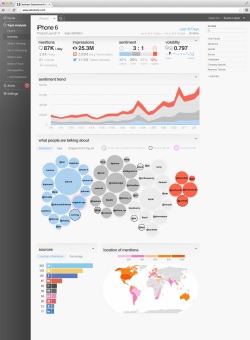Attensity Boosts Ability to Discover ‘Unknown’ Trends in Data
Most social analytics tools use “mentions” as a key criteria for measuring campaign success, market interest or user enthusiasm for products. But mentions on their own do not yield especially helpful insights, said Katherine Matsumoto, senior product manager & NLP strategist at Attensity, which today is updating its Attensity Q software with new features that help companies better detect “unknowns” and emerging themes in real-time social data.
“Social analytics has largely been limited up to this point by forming hypotheses and testing them – the hunting and pecking for insights that traditional search requires you to do,” Matsumoto said. “But there is a growing need for our customers to be presented with findings that they didn’t know to look for. These findings may be within their search topic, adjacent to it or many degrees removed through nested relationships.”
 According to the company, the new Attensity Q surfaces emerging themes, trends, anomalies and events around a main topic by allowing organizations to see the context within online conversations. The new release also makes it easier to build accurate vocabularies and brand-unique terms into queries.
According to the company, the new Attensity Q surfaces emerging themes, trends, anomalies and events around a main topic by allowing organizations to see the context within online conversations. The new release also makes it easier to build accurate vocabularies and brand-unique terms into queries.
Matsumoto offered the example of the Amazon Firephone. Using traditional search methodology, it is easy to see the product has a low number of mentions. But a recent search on Attensity Q showed a significant spike of interest in the Firephone on Sept. 16 that Attensity attributed to growing interest in Amazon's Firefly technology, which allows users to snap a picture of an object and buy it from Amazon.
On the 16th search company Slyce announced it was purchasing Pounce, an Israeli company that has technology similar to Firefly, and planned to release a retail shopping app powered by the technology. This spike in interest, highlighted by the discovery features of Attensity Q 1.1.0, illustrated “obvious excitement and interest” around the Firefly technology, Matsumoto said.
“With this information, an Amazon product marketer knows where to focus his or her energy. At this point, they are much better off than just wondering, ‘How can I get more interest in my product,' since they now have a theory to pursue,” she said.
The Attensity Q 1.1.0 software is equipped with:
- Sentiment analysis, which Matsumoto said enables identification of sentiment change over time, top terms by sentiment, filtering any insight by sentiment and viewing comparative sentiment for products, services, competitors and other key concepts. “Over the past 14 years, we’ve created a powerful, highly accurate sentiment analysis engine that is focused to account for all of the colloquialisms, jargon, social media-isms and slang that people use on Twitter, Facebook, blogs and forums,” she said.
- Trend analysis, which Matsumoto said utilizes Attensity's patented natural language processing (NLP) and proprietary trending algorithms to surface topics that are going viral or gaining a significant amount of volume in a rapid amount of time.
- Influencer analysis, which Matsumoto said helps organizations identify major social influencers in common topics of social content. “Some of our customers use this analysis to identify co-marketing opportunities with popular bloggers or celebrities who can influence their target market,” she said.
- Geo-spatial analysis, which surfaces insights by geolocation in an interactive map visualization to help users identify issues that are linked to a specific geographic location.
- Topic-based analysis, which categorizes social posts as related to marketing, customer service, products, operations and other relevant topics. The new release allows customers to define their own topics of interest in a company profile, Matsumoto said. “This feature brings your point of view to the analysis, making your key topics a central component of Q’s out-of-the-box analysis.”
While marketing organizations are the primary market for Attensity Q, Matsumoto said other business functions use it as well, including HR departments, which use it to identify employee sentiment and opportunities for improvement in the workplace through employer reviews and blogs, and legal departments, which use it to look for indicators of fraudulent activity such as employees offering to trade employee discounts to their social contacts.
Tools like Attensity Q are part of a broader data discovery trend that is driving increased interest in business intelligence.

Public relations, digital marketing, journalism, copywriting. I have done it all so I am able to communicate any information in a professional manner. Recent work includes creating compelling digital content, and applying SEO strategies to increase website performance. I am a skilled copy editor who can manage budgets and people.